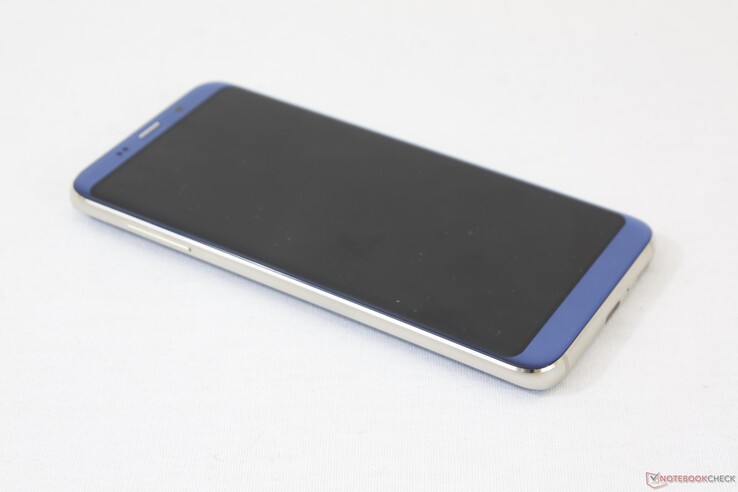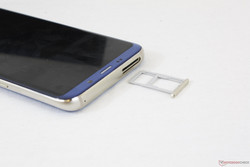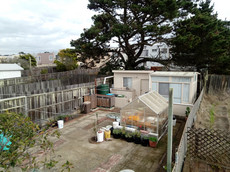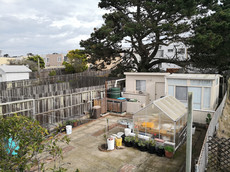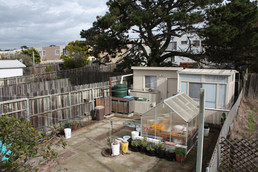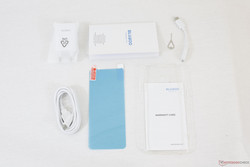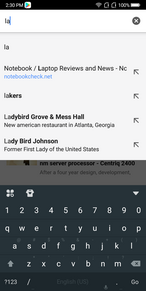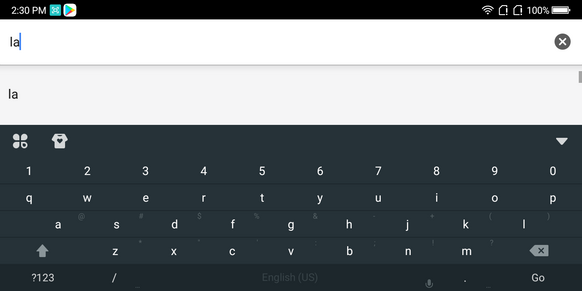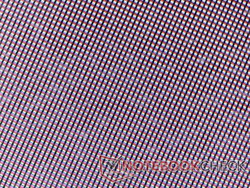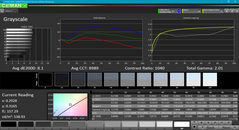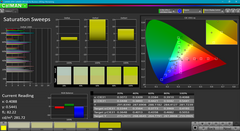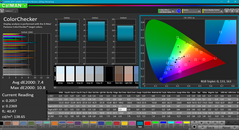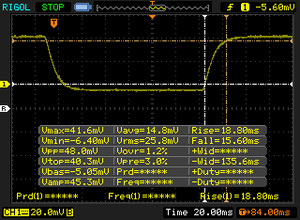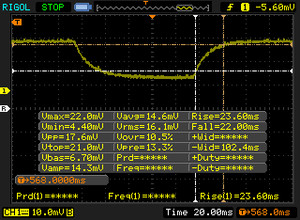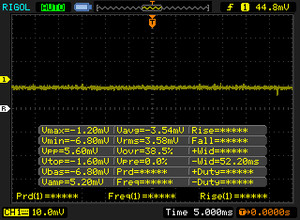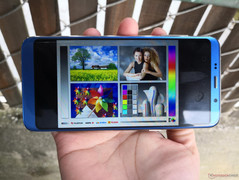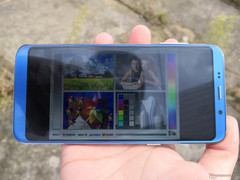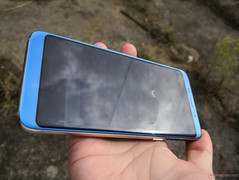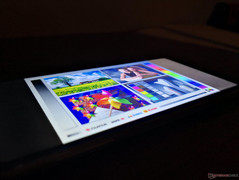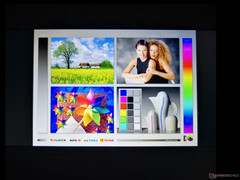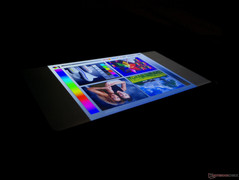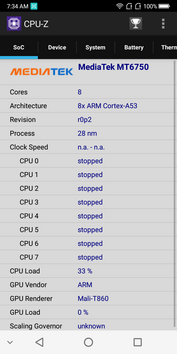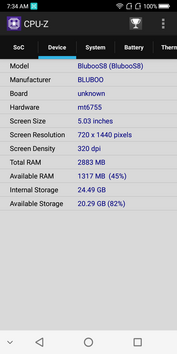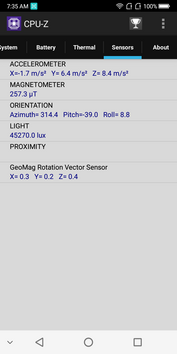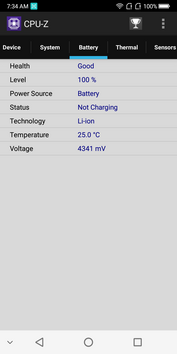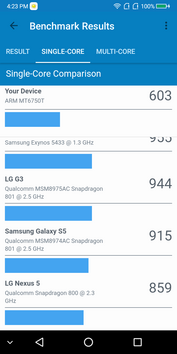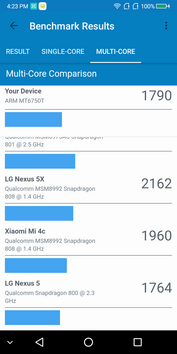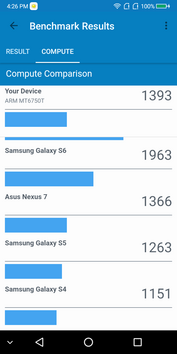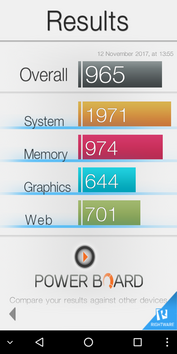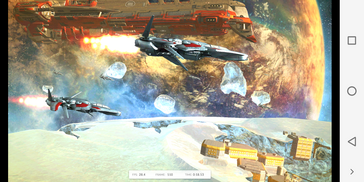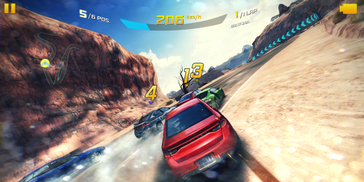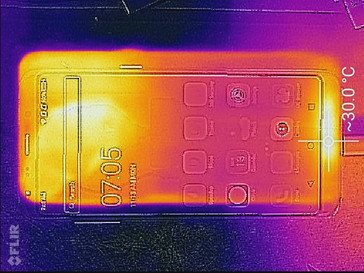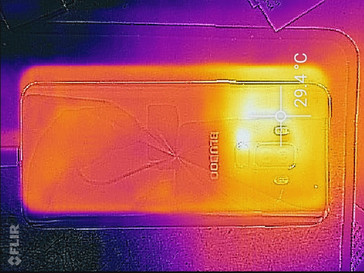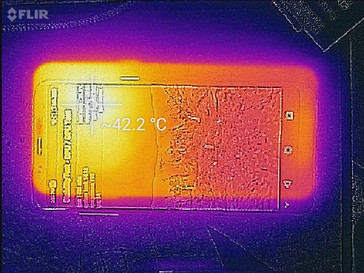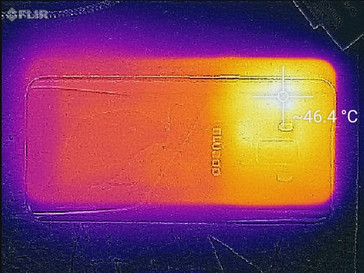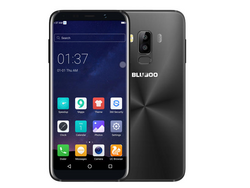Bluboo S8 Smartphone Review

Along with the Leagoo S8, the Bluboo S8 is riding behind the popularity of the Samsung Galaxy S8 with design features that mimic the South Korean flagship. There's no denying that the Bluboo model borrows heavily from the Samsung model and its name certainly makes no attempt to hide it.
The Bluboo S8 can currently be had for less than $150 USD as opposed to the the $700+ USD Galaxy S8. While they may look somewhat similar, there are a hosts of differences and cut corners on the Bluboo model that we will go over in this review page.
Case
The Bluboo is surprisingly dense and firm for the price. Despite being very nearly the same size as the proper Galaxy S8, it is about 30 percent heavier than the Samsung for a weighty first impression. Bluboo has crafted its version of the S8 to be smooth and round at every corner with no sharp edges to be as visually similar to the Samsung as possible even if its plastic materials are far inferior.
Quality is solid as well. Applying pressure on the plastic back results in no depressions and attempting to twist the unit will cause just slight creaking. There are some very small imperfections on our unit as the gaps between the blue back plate and chrome edges are not uniform and there is a grain-sized dent on the chrome edge near the volume rocker on our specific unit.
Connectivity
Conspicuously missing from the smartphone is a 3.5 mm audio jack. Typically, the audio jack may be omitted due to thickness limitations like on the Moto Z, but even the Galaxy S8 ships with a standard audio jack despite it being slightly thinner than the Bluboo model.
Wireless features include Bluetooth 4.0 and up to 802.11n connectivity. There are no IR, NFC, or Wi-Fi calling options.
| SD Card Reader | |
| maximum SDCardreader Maximum Transfer Rate | |
| average SDCardreader Average Transfer Rate |
Communication and GPS
WLAN functions without any issues when connected to our Linksys EA8500 test router. Average transfer rate sits at around 47 Mbps as expected from an 802.11n radio limited to 54 Mbps. GPS also appears to work as intended when running GPS Test, but it is unusable on the road due to no 3G/4G compatibility with major US carriers.
| Networking | |
| iperf3 transmit AX12 | |
| Samsung Galaxy S8 | |
| Huawei Y7 | |
| Bluboo S8 | |
| iperf3 receive AX12 | |
| Samsung Galaxy S8 | |
| Huawei Y7 | |
| Bluboo S8 | |
Telephone and Call Quality
The telephone software on our test unit appears to be buggy. Making calls is impossible as we would receive the error message "InCallUI has stopped" when attempting to place or receive calls and are unable to test call quality as a result. Our Bluboo software was at its latest version at the time of testing (v2.0.040).
As usual, North American users should make note that the Bluboo S8 was designed for Asian and European carriers. The smartphone lacks compatibility with most 3G and 4G networks in the United States. In theory, however, users should still be able to make calls.
Camera Quality
The rear 13 MP camera produces muddy pictures that are slightly overexposed with lost details in clouds and leaves. Colors have a green hue to them as is common on very cheap smartphone cameras. Noise is far too prevalent for indoor pictures.
Videos record at up to 1080p30. Quality is acceptable when outdoors under bright light, but is far too blurry when indoors.
Accessories and Warranty
Included extras are a clear flexible plastic cover, USB Type-C data cable, screen protector, Warranty card, SIM key, European-style AC charger, Quick Start guide, and the all-important USB Type-C to 3.5 mm audio adapter.
Warranty is the standard one-year limited warranty, although users in the US may have to pay for overseas return shipping. Please see our Guarantees, Return Policies & Warranties FAQ for country-specific information.
Input Devices and Operation
Touchscreen
The capacitive touchscreen can recognize up to five fingers at once whereas most other Android smartphones have 10-point screens. In practice, this has little significance for day-to-day use as very few apps take advantage of more than 4-point or 5-point touch features.
Touch-typing is responsive without any uneven input delays if typing very quickly. The 18:9 form factor, however, makes the keyboard feel more cramped than usual due to the narrower design. Simple actions like scrolling and pinch-to-zoom are registered reliably albeit with more frame skips and animation latency compared to mainstream smartphones with more refined software and nimble processors.
The rear fingerprint reader is unreliable. Multiple tries are required almost every time. The unlocking process is very fast for those rare moments where the fingerprint reader unlocks on the first attempt.
Lastly, the vibration feedback is both weak and loud on our unit. It seems as if the vibration is clattering some components inside of the phone to produce an abnormal sound that is very different from most other smartphones we've tested.
Display
The Bluboo S8 display attempts to mimic the round 18:9 displays of the latest flagships including the Galaxy S8, Galaxy Note 8, and LG V30. Picture quality is better than what one would expect in this price range with its respectable contrast ratio of 812:1 and a very bright backlight that's surprisingly almost as bright as on the Galaxy S8.
Nonetheless, a number of core drawbacks separate the Bluboo S8 display from its pricier alternatives. Firstly, the IPS panel is under a thicker layer of outer glass when compared to the Galaxy S8 and colors do not pop as much as a result. Secondly, response times are much slower than on many other cheap competitors for more noticeable ghosting when scrolling or gaming. Thirdly, colors are nowhere near as accurate as on the Galaxy S8 with higher DeltaE values and color deviation as expected on a budget smartphone. And lastly, the 1440 x 720 native resolution is less than half of the Galaxy S8 and Asus Zenfone AR for a comparatively grainier experience.
| |||||||||||||||||||||||||
Brightness Distribution: 95 %
Center on Battery: 544.2 cd/m²
Contrast: 812:1 (Black: 0.67 cd/m²)
ΔE ColorChecker Calman: 7.4 | ∀{0.5-29.43 Ø4.78}
ΔE Greyscale Calman: 8.1 | ∀{0.09-98 Ø5}
Gamma: 2.01
CCT: 8989 K
| Bluboo S8 SHARP, IPS, 5.7", 1440x720 | Samsung Galaxy S8 Infinity Display, Corning Gorilla Glas 5, Super AMOLED, 5.8", 2960x1440 | Asus ZenFone AR ZS571KL Super AMOLED, 5.7", 2560x1440 | Huawei Y7 IPS, 5.5", 1280x720 | LG Q6 IPS, 5.5", 2160x1080 | Samsung Galaxy J7 2017 Super AMOLED, 5.5", 1920x1080 | |
|---|---|---|---|---|---|---|
| Response Times | 90% | 88% | 9% | 21% | 89% | |
| Response Time Grey 50% / Grey 80% * (ms) | 45.6 ? | 5.6 ? 88% | 4.8 ? 89% | 59.2 ? -30% | 38 ? 17% | 4.8 ? 89% |
| Response Time Black / White * (ms) | 34.4 ? | 3.2 ? 91% | 4.8 ? 86% | 18.4 ? 47% | 26 ? 24% | 4 ? 88% |
| PWM Frequency (Hz) | 250 | 231.5 | 2315 ? | 257.7 | ||
| Screen | 31% | 6% | 24% | 29% | 27% | |
| Brightness middle (cd/m²) | 544.2 | 566 4% | 338 -38% | 467 -14% | 523 -4% | 454 -17% |
| Brightness (cd/m²) | 539 | 564 5% | 341 -37% | 456 -15% | 498 -8% | 463 -14% |
| Brightness Distribution (%) | 95 | 94 -1% | 90 -5% | 92 -3% | 88 -7% | 86 -9% |
| Black Level * (cd/m²) | 0.67 | 0.39 42% | 0.24 64% | |||
| Contrast (:1) | 812 | 1197 47% | 2179 168% | |||
| Colorchecker dE 2000 * | 7.4 | 2.7 64% | 3.7 50% | 4.3 42% | 6.4 14% | 2 73% |
| Colorchecker dE 2000 max. * | 10.8 | 5.4 50% | 7.9 27% | 6.8 37% | 11 -2% | 5.3 51% |
| Greyscale dE 2000 * | 8.1 | 3.1 62% | 4.9 40% | 3.5 57% | 7.4 9% | 1.7 79% |
| Gamma | 2.01 109% | 2.15 102% | 2.25 98% | 2.35 94% | 2.4 92% | 2.1 105% |
| CCT | 8989 72% | 6335 103% | 7286 89% | 7273 89% | 8641 75% | 6394 102% |
| Color Space (Percent of AdobeRGB 1998) (%) | 81.57 | |||||
| Color Space (Percent of sRGB) (%) | 99.87 | |||||
| Total Average (Program / Settings) | 61% /
45% | 47% /
27% | 17% /
21% | 25% /
28% | 58% /
43% |
* ... smaller is better
Calman measurements reveal inaccurate grayscale and colors, an overly cool color temperature, and poor RGB balance. Thus, while contrast is good, picture quality is nowhere near as good as pricier alternatives since most everything else about the Bluboo display is subpar.
Display Response Times
| ↔ Response Time Black to White | ||
|---|---|---|
| 34.4 ms ... rise ↗ and fall ↘ combined | ↗ 18.8 ms rise | |
| ↘ 15.6 ms fall | ||
| The screen shows slow response rates in our tests and will be unsatisfactory for gamers. In comparison, all tested devices range from 0.1 (minimum) to 240 (maximum) ms. » 92 % of all devices are better. This means that the measured response time is worse than the average of all tested devices (20.2 ms). | ||
| ↔ Response Time 50% Grey to 80% Grey | ||
| 45.6 ms ... rise ↗ and fall ↘ combined | ↗ 23.6 ms rise | |
| ↘ 22 ms fall | ||
| The screen shows slow response rates in our tests and will be unsatisfactory for gamers. In comparison, all tested devices range from 0.165 (minimum) to 636 (maximum) ms. » 77 % of all devices are better. This means that the measured response time is worse than the average of all tested devices (31.7 ms). | ||
Screen Flickering / PWM (Pulse-Width Modulation)
| Screen flickering / PWM not detected | ≤ 100 % brightness setting | ||
In comparison: 53 % of all tested devices do not use PWM to dim the display. If PWM was detected, an average of 8142 (minimum: 5 - maximum: 343500) Hz was measured. | |||
Ourdoor visibility is better than expected and not unlike on the Galaxy S8 since the backlight is almost as bright. Onscreen content remains easy to read if working under shade. Glare is still present, but it's kept to a minimum thanks to the strong backlight and above-average contrast. Direct sunlight will still overpower the display and cause washed out colors.
Performance
The octa-core MediaTek MT6750 SoC is commonly found on very low-end Android smartphones including the Leagoo Kiicaa Mix, LG K10, and the recent Doogee BL5000. According to Geekbench, multi-core performance is slower than even the budget Snapdragon 430 and comparable to the nearly five-year old Tegra 4. It is at least 3 to 5 times slower than the Exynos 8895 in the Galaxy S8 in terms of raw benchmark performance.
The 3 GB of system RAM is a healthy amount considering the price of the device. Still, we wouldn't mind giving up 1 GB of RAM if it had meant a much faster processor for swifter general operation.
| AnTuTu v6 - Total Score | |
| OnePlus 5 | |
| Samsung Galaxy S8 | |
| Asus ZenFone AR ZS571KL | |
| Sony Xperia XA1 | |
| Honor 6X | |
| Samsung Galaxy J7 2017 | |
| Huawei Y7 | |
| LG Q6 | |
| Bluboo S8 | |
| Doogee Shoot 1 | |
| PCMark for Android | |
| Work 2.0 battery life | |
| Samsung Galaxy J7 2017 | |
| Samsung Galaxy S8 | |
| Computer Vision score | |
| Samsung Galaxy S8 | |
| Samsung Galaxy J7 2017 | |
| Bluboo S8 | |
| Storage score | |
| Samsung Galaxy S8 | |
| Bluboo S8 | |
| Samsung Galaxy J7 2017 | |
| Work 2.0 performance score | |
| OnePlus 5 | |
| Asus ZenFone AR ZS571KL | |
| Samsung Galaxy S8 | |
| Huawei Y7 | |
| Samsung Galaxy J7 2017 | |
| LG Q6 | |
| Bluboo S8 | |
| Doogee Shoot 1 | |
| Sony Xperia XA1 | |
| Work performance score | |
| OnePlus 5 | |
| Asus ZenFone AR ZS571KL | |
| Samsung Galaxy S8 | |
| Huawei Y7 | |
| LG Q6 | |
| Samsung Galaxy J7 2017 | |
| Sony Xperia XA1 | |
| Honor 6X | |
| Doogee Shoot 1 | |
| Geekbench 4.4 | |
| Compute RenderScript Score | |
| Samsung Galaxy S8 | |
| OnePlus 5 | |
| Sony Xperia XA1 | |
| Samsung Galaxy J7 2017 | |
| Huawei Y7 | |
| LG Q6 | |
| Bluboo S8 | |
| 64 Bit Multi-Core Score | |
| OnePlus 5 | |
| Samsung Galaxy S8 | |
| Asus ZenFone AR ZS571KL | |
| Samsung Galaxy J7 2017 | |
| Sony Xperia XA1 | |
| Huawei Y7 | |
| LG Q6 | |
| Bluboo S8 | |
| 64 Bit Single-Core Score | |
| Samsung Galaxy S8 | |
| OnePlus 5 | |
| Asus ZenFone AR ZS571KL | |
| Sony Xperia XA1 | |
| Samsung Galaxy J7 2017 | |
| LG Q6 | |
| Huawei Y7 | |
| Bluboo S8 | |
| GFXBench | |
| on screen Aztec Ruins High Tier Onscreen | |
| OnePlus 5 | |
| Samsung Galaxy J7 2017 | |
| 2560x1440 Aztec Ruins High Tier Offscreen | |
| OnePlus 5 | |
| Samsung Galaxy J7 2017 | |
| on screen Aztec Ruins Normal Tier Onscreen | |
| OnePlus 5 | |
| Samsung Galaxy J7 2017 | |
| 1920x1080 Aztec Ruins Normal Tier Offscreen | |
| OnePlus 5 | |
| Samsung Galaxy J7 2017 | |
| on screen Car Chase Onscreen | |
| OnePlus 5 | |
| Samsung Galaxy S8 | |
| Asus ZenFone AR ZS571KL | |
| Sony Xperia XA1 | |
| Huawei Y7 | |
| Honor 6X | |
| LG Q6 | |
| Samsung Galaxy J7 2017 | |
| 1920x1080 Car Chase Offscreen | |
| OnePlus 5 | |
| Samsung Galaxy S8 | |
| Asus ZenFone AR ZS571KL | |
| Sony Xperia XA1 | |
| Honor 6X | |
| Huawei Y7 | |
| LG Q6 | |
| Samsung Galaxy J7 2017 | |
| Lightmark - 1920x1080 1080p | |
| Samsung Galaxy S8 | |
| Sony Xperia XA1 | |
| Bluboo S8 | |
| Basemark X 1.1 | |
| High Quality | |
| Samsung Galaxy S8 | |
| Sony Xperia XA1 | |
| Bluboo S8 | |
| Medium Quality | |
| Samsung Galaxy S8 | |
| Sony Xperia XA1 | |
| Bluboo S8 | |
| Epic Citadel | |
| Ultra High Quality | |
| Samsung Galaxy S8 | |
| Sony Xperia XA1 | |
| Bluboo S8 | |
| High Quality | |
| Bluboo S8 | |
| High Performance | |
| Bluboo S8 | |
Browser-based benchmarks like Jetstream, Octane, and WebXPRT rank the Bluboo S8 near the bottom of the barrel. The MediaTek MT6750 processor and integrated GPU are outclassed by budget-mainstream offerings like the Honor 6X or Sony Xperia XA1 powered by low-end Kirin and Helio SoCs, respectively.
| JetStream 1.1 - Total Score | |
| OnePlus 5 | |
| Samsung Galaxy S8 | |
| Asus ZenFone AR ZS571KL | |
| Sony Xperia XA1 | |
| Honor 6X | |
| Samsung Galaxy J7 2017 | |
| Doogee Shoot 1 | |
| Huawei Y7 | |
| Bluboo S8 | |
| LG Q6 | |
| Octane V2 - Total Score | |
| Samsung Galaxy S8 | |
| OnePlus 5 | |
| Asus ZenFone AR ZS571KL | |
| Samsung Galaxy J7 2017 | |
| Honor 6X | |
| Sony Xperia XA1 | |
| Doogee Shoot 1 | |
| Huawei Y7 | |
| Bluboo S8 | |
| LG Q6 | |
| Mozilla Kraken 1.1 - Total | |
| Bluboo S8 | |
| LG Q6 | |
| Doogee Shoot 1 | |
| Huawei Y7 | |
| Sony Xperia XA1 | |
| Honor 6X | |
| Samsung Galaxy J7 2017 | |
| OnePlus 5 | |
| Asus ZenFone AR ZS571KL | |
| Samsung Galaxy S8 | |
| WebXPRT 2015 - Overall | |
| Samsung Galaxy S8 | |
| OnePlus 5 | |
| Asus ZenFone AR ZS571KL | |
| Sony Xperia XA1 | |
| Samsung Galaxy J7 2017 | |
| Honor 6X | |
| Bluboo S8 | |
| LG Q6 | |
| Huawei Y7 | |
* ... smaller is better
Storage Devices
The 32 GB SSD returns average sequential transfer rates according to AndroBench. Sequential write rate, while still slow, is at least faster than on the latest Galaxy J7. Smartphones with UFS storage will easily run laps around the eMMC storage of the Bluboo S8.
| Bluboo S8 32 GB eMMC Flash | Samsung Galaxy S8 64 GB UFS 2.1 Flash | Asus ZenFone AR ZS571KL 128 GB UFS 2.0 Flash | Huawei Y7 16 GB eMMC Flash | LG Q6 32 GB eMMC Flash | Samsung Galaxy J7 2017 16 GB eMMC Flash | |
|---|---|---|---|---|---|---|
| AndroBench 3-5 | 95% | 52% | -17% | 18% | -16% | |
| Sequential Write 256KB SDCard (MB/s) | 55.9 | 53.5 -4% | 62.6 12% | 62.6 12% | 62.6 12% | 63.9 14% |
| Sequential Read 256KB SDCard (MB/s) | 75.9 | 63.9 -16% | 83.4 10% | 82.5 9% | 84.8 12% | 76.1 0% |
| Random Write 4KB (MB/s) | 12.37 | 15.25 23% | 13.51 9% | 6.9 -44% | 9.2 -26% | 10.54 -15% |
| Random Read 4KB (MB/s) | 38.24 | 127.2 233% | 88.4 131% | 53.2 39% | 54.3 42% | 25.86 -32% |
| Sequential Write 256KB (MB/s) | 77.6 | 193.2 149% | 142.8 84% | 33.2 -57% | 133.5 72% | 53 -32% |
| Sequential Read 256KB (MB/s) | 281 | 793 182% | 458.9 63% | 119.4 -58% | 263.1 -6% | 198.5 -29% |
Gaming
3DMark Ice Storm scores are similar to the Qualcomm Adreno 505 as found on budget phones like the LG Q6, Nokia 5, and Xiaomi Redmi 4X. Asphalt 8 runs smoothly on the Bluboo S8 as well as 720p Youtube videos to fit the native resolution of the display. Local 1080p H.264 video files play without noticeable frame skips even if the picture quality is not as crisp as we would like.
Emissions
Temperature
Surface temperatures are generally flat when idling on both sides of the device. Like most smartphones, the top half will become warmer after extended use since the battery occupies nearly the entire bottom half. The area closest to the MediaTek SoC can become as warm as 42 C compared to just 37 C on the Galaxy S8. Fortunately, the Bluboo never becomes uncomfortably warm during browsing loads.
(±) The maximum temperature on the upper side is 41.4 °C / 107 F, compared to the average of 35.2 °C / 95 F, ranging from 21.9 to 247 °C for the class Smartphone.
(-) The bottom heats up to a maximum of 46.4 °C / 116 F, compared to the average of 34 °C / 93 F
(+) In idle usage, the average temperature for the upper side is 28.2 °C / 83 F, compared to the device average of 32.9 °C / 91 F.
Speakers
The speakerphone is lacking in bass and overemphasizes treble as shown by our pink graph below. Sound quality is tinny as a result and volume could have been louder for outdoor use. The phone does not rattle if on higher volume settings.
Strangely, the speaker exhibits recurring static noises from time to time even when on mute. It's very low in volume, but the mere presence of static suggests imperfect wiring or interference surrounding the speaker.
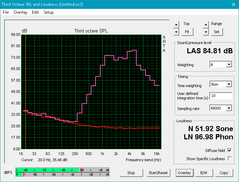
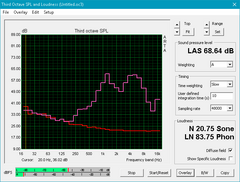
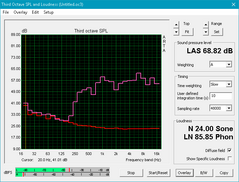
Bluboo S8 audio analysis
(±) | speaker loudness is average but good (77.9 dB)
Bass 100 - 315 Hz
(-) | nearly no bass - on average 30% lower than median
(+) | bass is linear (4.3% delta to prev. frequency)
Mids 400 - 2000 Hz
(±) | higher mids - on average 10.8% higher than median
(-) | mids are not linear (15.5% delta to prev. frequency)
Highs 2 - 16 kHz
(±) | higher highs - on average 10.8% higher than median
(±) | linearity of highs is average (10.7% delta to prev. frequency)
Overall 100 - 16.000 Hz
(-) | overall sound is not linear (43.5% difference to median)
Compared to same class
» 86% of all tested devices in this class were better, 0% similar, 13% worse
» The best had a delta of 11%, average was 35%, worst was 134%
Compared to all devices tested
» 95% of all tested devices were better, 0% similar, 4% worse
» The best had a delta of 4%, average was 24%, worst was 134%
Apple MacBook 12 (Early 2016) 1.1 GHz audio analysis
(+) | speakers can play relatively loud (83.6 dB)
Bass 100 - 315 Hz
(±) | reduced bass - on average 11.3% lower than median
(±) | linearity of bass is average (14.2% delta to prev. frequency)
Mids 400 - 2000 Hz
(+) | balanced mids - only 2.4% away from median
(+) | mids are linear (5.5% delta to prev. frequency)
Highs 2 - 16 kHz
(+) | balanced highs - only 2% away from median
(+) | highs are linear (4.5% delta to prev. frequency)
Overall 100 - 16.000 Hz
(+) | overall sound is linear (10.2% difference to median)
Compared to same class
» 7% of all tested devices in this class were better, 2% similar, 91% worse
» The best had a delta of 5%, average was 18%, worst was 53%
Compared to all devices tested
» 4% of all tested devices were better, 1% similar, 94% worse
» The best had a delta of 4%, average was 24%, worst was 134%
Frequency Comparison (Checkbox selectable!)
Graph 1: Pink Noise 100% Vol.; Graph 2: Audio off
Energy Management
Power Consumption
The Bluboo smartphone is not as efficient as a handful of other 5.5-inch and 5.7-inch alternatives including the Huawei Y7. When idling, the Bluboo will draw anywhere from 1.5 W to 2.5 W compared to roughly 0.5 W to 1.5 W on the Huawei Y7 or Samsung Galaxy S8. Perhaps unexpectedly, the Bluboo S8 is more demanding than the Galaxy S8 when under similar average loads. The poorer efficiency of the Bluboo model is in line with its shorter runtimes as well as shown in our next section.
Power consumption values for maximum load is lower than average load possibly due to throttling of the SoC when subjected to Stability Test stress.
| Off / Standby | |
| Idle | |
| Load |
|
Key:
min: | |
| Bluboo S8 MT6750, Mali-T860 MP2, 32 GB eMMC Flash, IPS, 1440x720, 5.7" | Samsung Galaxy S8 Exynos 8895, Mali-G71 MP20, 64 GB UFS 2.1 Flash, Super AMOLED, 2960x1440, 5.8" | Asus ZenFone AR ZS571KL SD 821, Adreno 530, 128 GB UFS 2.0 Flash, Super AMOLED, 2560x1440, 5.7" | Huawei Y7 435, Adreno 505, 16 GB eMMC Flash, IPS, 1280x720, 5.5" | LG Q6 435, Adreno 505, 32 GB eMMC Flash, IPS, 2160x1080, 5.5" | Samsung Galaxy J7 2017 7870 Octa, Mali-T830 MP1, 16 GB eMMC Flash, Super AMOLED, 1920x1080, 5.5" | |
|---|---|---|---|---|---|---|
| Power Consumption | 33% | 2% | 35% | 22% | 56% | |
| Idle Minimum * (Watt) | 1.6 | 0.78 51% | 0.88 45% | 0.57 64% | 0.92 42% | 0.39 76% |
| Idle Average * (Watt) | 2.4 | 1.1 54% | 1.24 48% | 1.61 33% | 2.19 9% | 1.06 56% |
| Idle Maximum * (Watt) | 2.5 | 1.16 54% | 1.26 50% | 1.62 35% | 2.24 10% | 1.08 57% |
| Load Average * (Watt) | 6.5 | 4.15 36% | 7.71 -19% | 3.09 52% | 3.38 48% | 1.82 72% |
| Load Maximum * (Watt) | 4 | 5.12 -28% | 8.64 -116% | 4.26 -7% | 4 -0% | 3.21 20% |
* ... smaller is better
Battery Life
The non-removable 3450 mAh battery is larger in capacity than the 3000 mAh battery in the proper Galaxy S8. Even after taking into the account the slower MediaTek processor in the Bluboo S8, battery life is still significantly shorter than on the Samsung flagship. Constant WLAN use will last about 6.5 hours on the Bluboo smartphone compared to almost 12 hours on the Samsung under similar brightness settings and conditions.
| Bluboo S8 MT6750, Mali-T860 MP2, Wh | Samsung Galaxy S8 Exynos 8895, Mali-G71 MP20, Wh | Asus ZenFone AR ZS571KL SD 821, Adreno 530, Wh | Huawei Y7 435, Adreno 505, 15.2 Wh | LG Q6 435, Adreno 505, 10.5 Wh | Samsung Galaxy J7 2017 7870 Octa, Mali-T830 MP1, Wh | |
|---|---|---|---|---|---|---|
| Battery runtime | 48% | 13% | 73% | 18% | 107% | |
| Reader / Idle (h) | 17.8 | 27.8 56% | 24.6 38% | 31.9 79% | 22.8 28% | 32.5 83% |
| WiFi v1.3 (h) | 6.5 | 12 85% | 7.4 14% | 11.9 83% | 8.4 29% | 15.1 132% |
| Load (h) | 4.3 | 4.4 2% | 3.7 -14% | 6.7 56% | 4.2 -2% | 8.8 105% |
Pros
Cons
Verdict
The Bluboo S8 looks great, feels good to hold, and has a surprisingly bright 18:9 display. Everything else is simply lukewarm at best or not even functional at worst.
For starters, North American users should be aware that the Bluboo S8 does not carry the necessary 3G or 4G radios for compatibility with major providers. Second, the telephone app would crash on our unit even after updating to the latest software version. Vibration is weak, colors are off, the fingerprint reader takes several tries, camera quality is grainy, there is static from the speaker seemingly at random intervals, and the lack of an audio jack feels insulting especially when the core basics are such a failure. Perhaps we simply received a faulty unit, but at the same time, this certainly reflects poorly upon Bluboo's quality assurance standards and longevity of the device.
A Galaxy S8 clone on the surface, but an ultra-budget phone within. We don't expect much from a smartphone for under $150 USD except for functional basics, but the Bluboo S8 can't even get calling or speakerphone to work reliably.
Bluboo S8
- 11/16/2017 v6 (old)
Allen Ngo




